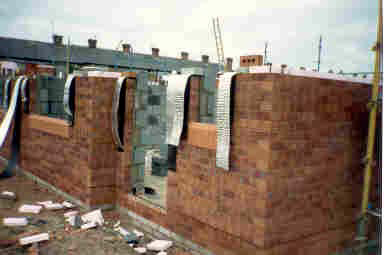


Are you sure you want to reset the form?
Your mail has been sent successfully
Are you sure you want to remove the alert?
Your session is about to expire! You will be signed out in
Do you wish to stay signed in?
/R/Riley-construction-technology-1/8_9.jpg) In order to resist the passage of moisture from the ground it is necessary to install an impervious layer or damp-proof course into the walls at low level. Here we see the black DPC passing over the threshold of a door opening in both inner and outer leaves. Note the weep holes beneath.
In order to resist the passage of moisture from the ground it is necessary to install an impervious layer or damp-proof course into the walls at low level. Here we see the black DPC passing over the threshold of a door opening in both inner and outer leaves. Note the weep holes beneath./R/Riley-construction-technology-1/8_10.jpg)
/R/Riley-construction-technology-1/8_11.jpg)
/R/Riley-construction-technology-1/8_12.jpg) Cavity ties are fitted with restraint clips to hold insulation against the inner leaf. If the insulation falls across the cavity a possible route for water is created.
Cavity ties are fitted with restraint clips to hold insulation against the inner leaf. If the insulation falls across the cavity a possible route for water is created./R/Riley-construction-technology-1/8_13.jpg) Where openings are formed it is essential to provide appropriate details to retain the performance of the wall. Here we see the galvanised steel lintel above the opening supporting the inner and ouer leaf. The cavity is closed at the reveal by turning a block from the inner leaf to abut the brickwork of the outer. At this point a vertical damp-proof course is installed, clearly visible here.
Where openings are formed it is essential to provide appropriate details to retain the performance of the wall. Here we see the galvanised steel lintel above the opening supporting the inner and ouer leaf. The cavity is closed at the reveal by turning a block from the inner leaf to abut the brickwork of the outer. At this point a vertical damp-proof course is installed, clearly visible here./R/Riley-construction-technology-1/8_8.jpg)
/R/Riley-construction-technology-1/8_7.jpg)

/R/Riley-construction-technology-1/8_5.jpg) Where the cavity is closed there is the risk of moisture penetration and the possibility of ‘cold-bridging’ occurring. In order to resist these it is necessary to provide dpcs around all openings. Those used here are insulated with an effective insulation material bonded to the black/silver dpc material.
Where the cavity is closed there is the risk of moisture penetration and the possibility of ‘cold-bridging’ occurring. In order to resist these it is necessary to provide dpcs around all openings. Those used here are insulated with an effective insulation material bonded to the black/silver dpc material./R/Riley-construction-technology-1/8_3.jpg)
/R/Riley-construction-technology-1/8_2.jpg)
/R/Riley-construction-technology-1/8_1.jpg) All building materials suffer from a degree of dimensional change as a result of variation in temperature and moisture content. Masonry walls must be considered in this respect and it is necessary to include movement joints at varying distances, depending on the material used.
All building materials suffer from a degree of dimensional change as a result of variation in temperature and moisture content. Masonry walls must be considered in this respect and it is necessary to include movement joints at varying distances, depending on the material used.